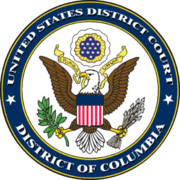TikTok v. Trump
| TikTok v. Trump | |
|---|---|
 | |
| Court | United States District Court for the District of Columbia |
| Full case name | TikTok, et al. v. Donald J. Trump, et al. |
| Case history | |
| Related action | U.S. WeChat Users Alliance v. Trump |
TikTok v. Trump is a pending lawsuit before the United States District Court for the District of Columbia. The lawsuit was originally filed by TikTok as a challenge to President Donald Trump's executive order prohibiting the usage of the application in five stages, the first being the prohibition of downloading TikTok. On September 27, 2020, a preliminary injunction was issued by Judge Carl J. Nichols blocking enforcement of Executive Order 13942.[1]
Background
TikTok is a video-sharing social networking application where individuals may share videos that are 3-15 seconds long, and looping videos 3-60 seconds long. Owned by a Beijing-based company, Bytedance,[2] the application has been met with security concerns. For example, the United States Navy and the U.S. Army previously instructed their officers to delete TikTok from devices owned by the government.[3][4][5] On August 6, 2020, President Donald Trump issued an executive order banning the apps WeChat and TikTok, citing national security concerns.[6] Subsequently, TikTok announced that it was filing suit against Trump on August 24, 2020.[7] The Department of Commerce also published an identification of prohibited activities on WeChat and TikTok. [8]
Proceedings
The initial complaint was filed by TikTok on September 18, 2020. On September 23, 2020, TikTok also filed a motion for a preliminary injunction, which was granted in part and denied in part by Judge Carl J. Nichols on September 27, 2020. In his memorandum opinion, Judge Nichols concluded that TikTok was likely to succeed on its merits, because "informational materials" were being transferred on the application. Irreparable harm was also shown due to the potential competitive losses of TikTok if the ban were to be enacted. Judge Nichols also found that the government's interest was insufficient to warrant a full-on ban of TikTok, and thus granted plaintiffs a preliminary injunction with respect to the "prohibited transactions" listed in "Paragraph 1 of the Commerce Identification."[9][10]
References
- ^ "TikTok Wins Reprieve From U.S. Ban". The New York Times. September 27, 2020.
- ^ "ByteDance". www.bytedance.com. Archived from the original on 21 August 2020. Retrieved 10 August 2020.
- ^ Bell, M.B.; Wang, Echo (20 December 2019). "U.S. Navy bans TikTok from government-issued mobile devices". Reuters. Archived from the original on 21 December 2019. Retrieved 21 December 2019.
- ^ Calma, Justine (31 December 2019). "US Army bans soldiers from using TikTok". The Verge. Archived from the original on 31 December 2019. Retrieved 31 December 2019.
- ^ Harwell, Drew; Romm, Tony (31 December 2019). "U.S. Army bans TikTok on military devices, signaling growing concern about app's Chinese roots". The Washington Post. Archived from the original on 31 December 2019. Retrieved 5 January 2019.
- ^ "Trump Targets WeChat and TikTok, in Sharp Escalation With China". The New York Times. August 6, 2020.
- ^ "TikTok sues Trump administration over U.S. ban, calls it an election ploy". Reuters. August 24, 2020.
- ^ "Commerce Department Prohibits WeChat and TikTok Transactions to Protect the National Security of the United States". Department of Commerce. September 18, 2020.
- ^ TikTok v. Trump, No. 1:20-cv-02658-CJN (Order) (D.D.C. Sep. 27, 2020).
- ^ TikTok v. Trump, No. 1:20-cv-02658-CJN (Opinion) (D.D.C. Sep. 27, 2020).
